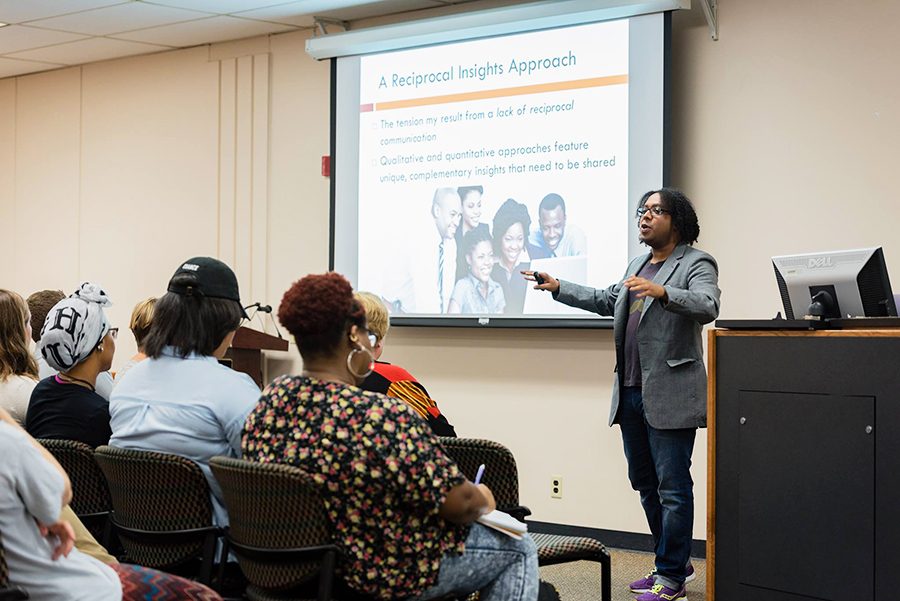Gender identity is a complex subject that can be difficult to explain.
Charlotte Tate gave professors and students an informative talk on the multifaceted view of gender identity that is cis and trans-centered in the Love Library on Wednesday, Oct. 12.
Tate was San Diego State’s first LGBTQ Pride Week speaker this year. She is a psychology professor at San Francisco State University and a respected social personality psychologist.
She is a butch-presenting lesbian and open trans woman. Tate did not disappoint with her two-hour talk that was filled with humorous jokes and thought-provoking topics.
Tate’s goal for her presentation was to present a quantitative perspective on gender identity in a way that would not oppose qualitative perspectives.
“I hope to have reciprocal communication,” Tate said. “Both the interpersonal and intrapersonal approaches are necessary for complete gender understanding.”
Tate started off her presentation by addressing “being gender” and “doing gender.”
“To do gender is to engage in social behaviors that are not or are ‘allowed for women,’” Tate said. “To be gender is to have a deep sense of a personally felt experience about self-categorization.”
Tate went on to explain that genitals are not what tell you about gender.
“Genitals are different than a person’s self-categorization,” Tate said.
Tate’s presentation depicted gender as a bundle of constructs.
“If gender came in a little box, these aspects would come out,” Tate said.
On the screen, five different shapes flew out of the gender box. She joked that the animations on her PowerPoint had taken a lot longer than they looked like they would and the audience laughed in unison.
This animation showed that gender is made up of different aspects other than one’s genitalia. Elements such as birth assigned gender category, current gender identity, gender roles and gender presentation are each vital in identifying one’s gender identity.
“Sexual orientation has to respect that there are five different facets to gender,” Tate said. “In psychology, we are good at talking about it. We are not very good at measuring it.”
Tate then used celebrities Portia de Rossi and Rachel Maddow as examples of different ways that women present themselves.
Both lesbians and women, however Portia is a “more expected presentation.”
“Obviously the social presentation is not going to be the key thing to determine if someone is a man or woman,” Tate said.
Tate’s talk turned to explain binary vs. non-binary gender experiences.
If a person experiences a gender identity as either female or male, this person can be described as having a “binary experience of gender.”
According to Tate’s perspective, cisgender and transgender simply describe developmental profiles to this identity. On the other hand, some people experience gender identity in something more complex than an either or way.
“Genderqueer or nonbinary are terms used by people that have this gender experience,” Tate said. “I may be wrong about this, as I am a binary person. I identify as a woman, yet I am telling you about a non-binary experience. This is just my own analysis.”
Tate was not afraid to address the fact that her analysis could be wrong, as she does not identify as gender queer herself. Tate also expressed that psychology is not doing much of anything to clarify the topic of gender identity.
“We have been f-cking it up since 1888, before psychology was even a thing,” Tate said. The crowd laughed as she continued. “Homosexuality as a mental disorder was bad science, even for that time.”
Tate brought up the fact that surveys or questionnaires, the question, “How do you currently identify?” consists of only two answers: male or female.
Tate said she wanted to find a way to ask this question in a more precise way.
Tate presented her Gender Self Overlap Index.
“It sounds healthy when you say the acronym,” Tate said.
The GSOI is a way to index the felt-sense of gender as gender-categorization.
“Maybe there is a ‘felt-sense’ of gender categorization,” Tate said. “But how do we measure that?” This is where the GSOI comes in.
The GSOI utilizes diagrams and drawings to describe one’s felt-sense of gender identity, as words often lack in accurately depicting this. What makes us feel close to others is difficult to capture in words, and gender identity is no different.
After testing the GSOI out on different populations in San Francisco, it proved to be a success.
As a result of the more inclusive demographics, populations were showing different patterns almost immediately. The GSOI appears to successfully track one’s felt-sense of gender identity as self-categorization.
“I am trying to say that I am a lesbian by how I present myself,” she said. “But also, I am trying to say that I am a woman. We are all using the same channel to do this social presentation.”
“Tate’s presentation about gender identity was very interesting,” criminal justice senior Maria Castaneda. “Tate covered the different gender roles and expectation for women, men, boys and girls.”
Tate was able to successfully identify the issues in psychology while also informing professors and students on this complex topic of gender identity.















